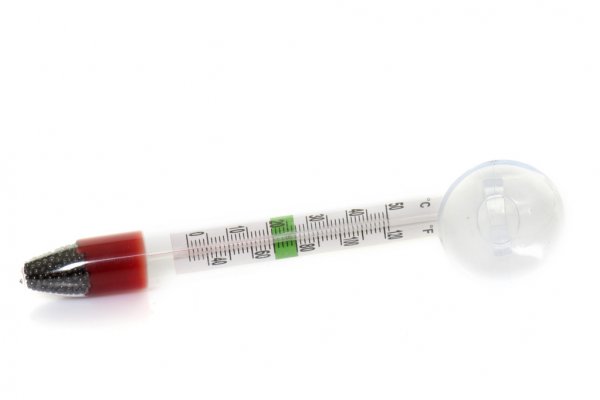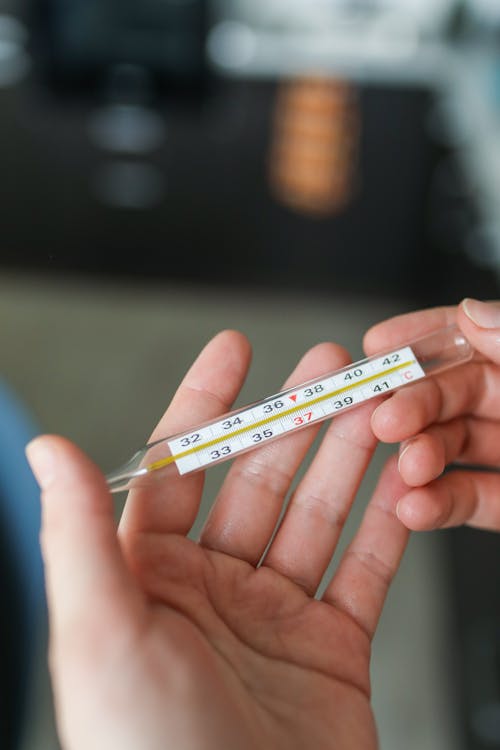When setting up a new aquarium, there are certain pieces of equipment that every aquarist has to buy. There is the hood, the light bulbs, the filter, the substrate, a heater… And, of course, a good thermometer! Having a thermometer means you can quickly tell whether the temperature is right where your fish like it or in need of adjustment.
Our Top Picks for the Best Aquarium Thermometers of 2025
A thermometer does have a straightforward job: giving you a readout of the aquarium water temperature. But as you’ll come to appreciate, there are quite a few different ways of doing so – and many of these thermometer models even have added features to aid you in keeping the water temperature right where you want it! So let’s dive into this list of the 10 best aquarium thermometers of 2025 together.
- Zacro LCD Digital Aquarium Thermometer
- Capetsma Digital Touchscreen Aquarium Thermometer
- Marina Deluxe Floating Thermometer with Suction Cup
- Marina Standing Thermometer
- SunGrow Aquarium Sticker Thermometer
- Fischuel Submersible Aquarium Thermometer
- American Thermal Liquid Crystal Aquarium Thermometer
- Marina “Diameterorado” Digital Aquarium Thermometer
- Penn Plax Floating Aquarium Thermometer
- Hygger Stick-on Digital Aquarium Thermometer with Alarm
Types of Aquarium Thermometers
Believe it or not, there is quite a bit of variety out there in terms of choosing an aquarium thermometer! They come in three main styles, which we’ll outline for you here.
Floating or Standing Aquarium Thermometers
When looking into a tank to measure the water temperature, there is a good chance you will see a glass tube floating along the surface. It may also be standing erect on the gravel or hanging on the side of the tank rim. Also known as a liquid thermometer, these models hold a small amount of mercury or alcohol.
As the tank temperature goes up, the liquid inside expands with the collected heat, marking its progress against the bright cardboard backing. And when the water temperature goes down, the reverse happens! To find the correct water temperature, simply match the highest level reached by the fluid to the units displayed.
This style of aquarium thermometer gives fairly accurate readings, usually within 1-2 degrees. While that’s enough for most purposes, you may need a more accurate thermometer at times.

Digital Aquarium Thermometers
Ultimate accuracy is where a digital aquarium thermometer comes in! A digital thermometer measures changes in the expansion of the metal probe that sits within the tank rather than any liquid. Plastic suction cups affix the probe to the sides of the glass tank so the water temperature can be displayed continually via an LCD display.
The water temperature range offered by a digital aquarium thermometer is much more precise. They can sense shifts down to 0.01-degree changes in ambient temperature. A wire runs from the probe submerged underwater to the actual thermometer unit sitting outside your fish tank.

Stickable Aquarium Thermometers
Stickable aquarium thermometers are also known as LCD thermometers or LCD digital thermometers, which can be confusing when you think about the battery-powered models mentioned earlier. Stick-on thermometers do use liquid crystals and readout in digits. But they aren’t the same as the LCD digital display used in a true digital thermometer.
Instead, as the temperature changes, the colors of the liquid crystals also shift. Since the color changes are gradual, these tend to give the least accurate temperature reading of any thermometer. Usually, you’re going to be within 1-2 degrees of your target temperature, sometimes 3 degrees off with models that have large gaps in number coverage. The more temperature gradations the thermometer has, the more accurate your reading of the tank temperature.
When shopping for a thermometer, make sure that your LCD thermometer is the kind you’re looking for. An LCD digital aquarium thermometer is quite different from an LCD thermometer that sticks on the exterior glass.
Why Should I Be Using a Thermometer in My Tank?
The main purpose of an aquarium thermometer is pretty straightforward: we want one in order to measure the water temperature at all times. Many of the fish we are caring for are from tropical climates, where the temperature tends to be much warmer than where we live. The ambient room temperature can be enough in some tropical countries where you need no heater in the tank.

But in most cases, we will be using both a heater and a thermometer to keep the temperature range at a preferred level. Usually, that’s anywhere from 72-84 degrees Fahrenheit (22-29 Celsius). Thermometers can alert us if the temperature falls during a power outage or when too much cold water is added during a water change. Having to treat cold water shock can be averted entirely with an accurate reading from a thermometer.
If you’re looking to breed your fish, then you’ll likely need to adjust the aquarium water temperature to match a specific range. Seasonal cues matter a lot to fish, and shifts in water temperatures are the main ways fish sense the onset of the breeding season.
Reviewed: The 10 Best Aquarium Thermometers
1. Zacro LCD Digital Aquarium Thermometer

At 1.46 x 2.17 inches, this digital thermometer is hard to beat in terms of compactness. The suction cups allow you to both attach the temperature probe to the inside glass and place the digital thermometer against the glass to keep things looking tidy.
Best of all, the minimalist design uses just a single power button, ensuring digital monitoring of water temperature doesn’t become a complex affair. A single LR44 button cell battery is included, and all it takes to power this unit!
Pros:
- Straightforward and easy to use
- Compact; digital pocket thermometer
- Easily attaches to fish tank glass
- Accurate down to 0.01 degrees
Cons:
- Unlike submersible aquarium thermometers, this unit should not get wet
- Few additional features
2. Capetsma Digital Touchscreen Aquarium Thermometer

For folks looking for a few more functions, it’s hard to beat the digital thermometers on offer from Capetsma! Thanks to the 2 included CR2 batteries; the unit will run for ages before needing replacements. But the real draw is the touch interface, allowing you to shift the temperature reading from Fahrenheit to Celsius.
You also have the ability to set a safety zone indicator. If the temperature drops or rises too high, the numbers begin flashing to alert you to a possible problem. Lastly, the temperature scale covers 32°F – 158°F, ideal for any aquarium setup!
Pros:
- Clear background for a more stylish look
- Several touch functions beyond simply monitoring the temperature
- High measurable temperature range
- Eay to read LCD readout
Cons:
- A little less affordable than other digital display thermometers
- A larger unit than most of the others listed here
3. Marina Deluxe Floating Thermometer with Suction Cup

The Marina floating thermometer is a classic glass thermometer that needs no power to provide constant temperature readings. And since it floats, you won’t have to get your whole arm wet to make adjustments or get it back. Marina also thoughtfully included a suction cup so you can attach it to the glass if you’d prefer to keep it in the same place continually.
The only drawback with this model is that they use a blue background rather than the classic yellow. It can be hard to see the mercury level when measuring temperature in the ideal range.
Pros:
- Affordable, straightforward thermometer
- Floating thermometer is easy to access from the surface
- Suction cup allows you to attach the thermometer if desired
Cons:
- A little harder to read the ideal temperature range
- Water temperature may fluctuate more often near the surface
4. Marina Standing Thermometer

Unlike their floating thermometer, Marina’s standing thermometer is designed to go straight to the bottom. Once there, the unit uses the weight of all the metal inside to stand up along your gravel or sand bed, where it can continually measure water temperature.
The green, safe zone this unit offer is easier to read than the purple of the floating version. And it covers an ideal 70-80°F, which is preferred by the majority of tropical fish. The extra weight also makes this unit harder for bottom-dwelling fish to dislodge while hunting for food!
Pros:
- Easy to use; no setup needed
- Requires no additional power to operate
- Samples water temperature near the bottom rather than the top
Cons:
- Harder to reach if you need to make an adjustment
- Not as accurate as a digital thermometer
5. SunGrow Aquarium Sticker Thermometer

Thermometer sticker strips have some distinct advantages worth considering. But one disadvantage is that most have a narrow range of temperature to display. SunGrow remedies this problem by using a scale that ranges from 64-94°F, well above and below the temperature favored by tropical fish.
No suction cup is needed since you can stick it directly onto your aquarium glass. And stick-on models require no power; the colors shift along with the water temperature! Just keep direct sunlight away from any sticker thermometer since the light will cause it to read hotter than it actually is.
Pros:
- No power needed to monitor the temperature range
- Wide temperature range of 64-94°F
- No suction cups or other accessories needed
- Fahrenheit and Celsius displayed
Cons:
- Only accurate to within 2 degrees Fahrenheit
6. Fischuel Submersible Aquarium Thermometer

The main drawback of using an LCD digital aquarium thermometer is that they are often not entirely water-resistant. However, this design by Fischuel is very different. Stick on submersible thermometers like this can give more accurate readings since they aren’t being affected by the glass barrier or the ambient air temperature.
Other digital thermometers use a probe and cord to overcome this weakness, but these can also be damaged in accidents. And being IPX-8 waterproof, the Fuschuel Submersible Aquarium Thermometer can be submerged down to 100 inches with no issues.
Pros:
- Fully submersible thermometer
- Uses a single watch battery
- Accurate to 0.01 degrees
Cons:
- Takes getting wet to change the battery
- Many users report switching from Fahrenheit to Celsius to be difficult
- Not as aesthetically pleasing as many other digital thermometers
7. American Thermal Liquid Crystal Aquarium Thermometer

One issue I find with many thermometers is that the thermometer display takes up too much space. They can be distracting from your fish, plants, and aquarium design. American Thermal’s Liquid Crystal design addresses this by virtue of its small size.
The scale for measuring aquarium water is smaller than that offered by the SunGrow design; only 68-82°F. But this is still fully within the safe zone for the majority of fish; it’s rare to go much higher or lower than these parameters. That’s why sticky LCD thermometers like these are often found in small aquarium starter packs. They get the job done effectively and without standing out very much!
Pros:
- Does not take up much visual real estate
- Affordably priced
- No setup or batteries required
Cons:
- Relatively low thermometer accuracy
- Can’t be moved once it’s attached
- Only Fahrenheit scale, no Celsius
8. Marina ” Diameterorado” Digital Aquarium Thermometer

The Marina “Diametorado” is a liquid crystal digital aquarium thermometer with ample coverage for aquarium fish (66-88°F). The high end is a little extreme, but 82-86°F is useful if you’re into breeding tropical fish, which often need these temperatures.
The Marina also has a Celsius scale (19-31°C) on the opposite side, making it perfect regardless of where in the world you live. At 3 inches long, this LCD digital aquarium thermometer is just large enough to be easily read without detracting from the appearance of your fish tank. And setting it up is as simple as can be: all you need to do is attach it securely using the adhesive backing!
Pros:
- Excellent readability
- Plenty of steps in the degree scale for accurate temperature readings
- No batteries, suction cups, or other accessories needed
- Wide temperature range of 66-86°F
Cons:
- Can’t be moved once it’s attached
9. Penn Plax Floating Aquarium Thermometer

Penn Plax is a popular maker of aquarium products, so it’s no surprise to see one of their products on this best aquarium thermometer list! Like the Marina Floating Thermometer, the Penn Plax design includes a suction cup in case you decide you want it to stay in the same place. And rather than the slightly more difficult to see purple scale Penn Plax stuck with a traditional green, which is easier to see against the red interior fluid.
Unlike many digital aquarium thermometer styles, liquid and glass designs don’t need batteries or anything else. Simply drop it into your tank and watch it give an accurate water temperature reading! Being fully submerged in your fish tank it’s also entirely unaffected by the ambient air temperature.
Pros:
- Included suction cup to attach to the glass of fish tanks
- Floating design for easy access
- Bright green “safe zone” for easy reading
Cons:
- A little pricier than other floating thermometers
10. Hygger Stick-on Digital Aquarium Thermometer with Alarm

Hygger is a newer manufacturer of products for both fresh and saltwater tanks. And this LCD digital aquarium thermometer of theirs has some interesting features worth exploring! For starters, it does not use a cord and probe; instead, the Hygger takes temperature readings through the aquarium glass.
The main benefit to doing so is fewer cables getting twisted about your tank! But the main downside is that it’s not as accurate as other digital aquarium thermometers. Instead of getting within 0.01°F, you’re looking at 1-2 degrees of accuracy.
We also have an option to set up high and low-temperature alarms, alerting us to potential equipment malfunctions through a continuous beeping sound. The digital display is simple and easy to read as well!
Pros:
- High and low-temperature alarm
- Straightforward digital display
- No cables or plastic probe
Cons:
- Not as accurate as other LCD digital aquarium thermometers with probes and cables
A Buyer’s Guide to Choosing the Best Aquarium Thermometers
With all of the incredible aquarium thermometer options available here and elsewhere, choosing the best digital aquarium thermometer can feel like a bit of a chore. So here are some good questions to ask yourself when shopping around to help narrow your options down a bit!
What Sort of Temperature Accuracy Do I Need?

Generally speaking, there’s no competition here between using a battery-powered digital aquarium thermometer with an LCD screen versus the other types. Digital thermometers can give accurate readings down to 0.01°F thanks to the probe running from the unit into your fish tank.
That said, floating and standing thermometers are still very accurate; to within 0.5-1°F. They aren’t always as quick to be deciphered, though. And they take a few minutes to readjust in the face of sudden temperature shifts, such as during a large water change.
Stickable thermometers are the least accurate models due to the air temperature and the barrier formed by the glass. But they still get within 1-2°F, which is plenty accurate for most purposes!
Temperature Readout and Visibility
The problem with some LCD digital aquarium thermometer designs is that reading the result isn’t so easy. Models with large numbers and a large display make it easier to read the digits as far as the other side of the room. The simple black and white display make it even more effortless.
But smaller designs may require you to be right up against the tank. Liquid crystal sticky thermometers are more difficult. And glass floating or standing thermometers are the most challenging; you have to be right up against the fish tank glass to properly read one.
How Easy is it to Set Up the Aquarium Thermometer?
There are a few units with a complex setup process. If they have an alarm, temperature alert, or other features, then you’ll need to program them. Many digital thermometers also need to be shifted from Fahrenheit to Celsius, which may take a few button presses. If you’re allergic to too many additional features, then simpler models might be right for you!
How Rugged a Thermometer Do I Need?
Most aquarium thermometers are some of the hardest-to-break pieces of aquarium equipment that you own. But many of the more advanced LCD digital aquarium thermometer models can be a bit fragile. With some designs, the LCD screen can be a little sensitive to too much pressure. Accidentally applying too much force when attaching it to your fish tank can result in a cracked screen.
Floating and standing glass thermometers, on the other hand, will last for decades so long as you don’t drop them on the floor or knock it against your aquarium driftwood or rock. Stickable aquarium thermometers are also quite durable since they are too flexible to be broken easily!
Which Aquarium Thermometer is Best?
Honestly, we like many different aspects of each of these fish tank thermometers! But if we have to choose one among the top picks for the 10 best aquarium thermometers, then the Zacro LCD Digital Aquarium Thermometer is hard to beat! It’s simple to set up and accurate down to 0.01°F! The unit is very affordably priced, uses a simple watch battery for power, and the LCD display is easily readable with little extra info cluttering it!
Some folks may find needing to use a battery to power the unit off-putting. Or they don’t want to fuss with cords and probes. In that case, take a look at the Penn Plax Floating Aquarium Thermometer. It uses a classic mercury scale with green backing to highlight the ideal temperature range for fast, sensitive readings. And while it does float, the included suction cup allows you to attach it to the fish tank wall as needed.
But sometimes, you don’t want wet fingers and prefer being able to tell the temperature at a quick glance. If you don’t mind being a couple of degrees off on occasion, then stickable designs like the SunGrow Aquarium Thermometer will be perfect! They attach directly to the exterior glass and give a solid breakdown of the temperature in both Fahrenheit and Celsius.
That said, each of these thermometer designs has something to offer most aquarists. What features many will decide are necessary may be entirely useless for you, and vice versa. Good luck choosing your favorite, and do let us know what you decide on!

